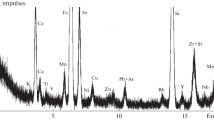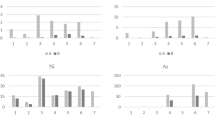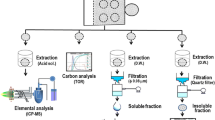Abstract
An analytical survey of fly ashes, bottom ashes and mixtures of the two for 36 elements, soluble salts and radioactivity was conducted. The ashes were taken from approximately one-fourth of the municipal solid waste incinerators presently operating in the United States. The concentrations of a number of toxic elements such as As, Cd, Cr, Cu, Hg, Ni, Pb, Sb, and Zn in specific ashes were high. The levels of radioactivity were not significant from a health standpoint. A number of ashes were exceedingly high in organic matter, indicating grossly inadequate conditions during incineration. Soluble salt content was appreciable in the ashes. The possible sources of elements in refuse and their behavior and fate during refuse incineration are discussed with respect to their chemical forms and properties and incinerator operating parameters. Variability of metal concentrations in ash with time of sampling and their solubilization in landfills are also considered.
Similar content being viewed by others
References
Behel D, Jr, Giordano PM, Stephenson DR (1986) Attenuation of Cd and Pb solubility in municipal waste incinerator ash. Commun Soil Sci Plant Anal 17:385–392
Bennett RL, Knapp KT (1982) Characterization of paniculate emissions from municipal waste water sludge incinerators. Environ Sci Technol 16:831–836
Brekke DD, Landolt RR, Zimmerman NJ (1985) Measurements of effluent radioactivity during the incineration of carcasses containing radioactive microspheres. Health Phys 48:339–341
Brown RC, Peterson RL (1970) An investigation of radioactivity in incinerator ash. J Occupat Med 12:173–177
Brunner PH, Mönch H (1986) The flux of metals through municipal solid waste incinerators. Waste Mgt Res 4:105–119
Bush D, Hundal RS (1972) The fate of radioactive materials burnt in an institutional incinerator. Health Phys 24:564–568
Campbell WJ (1976) Metals in the wastes we burn? Environ Sci Technol 10:436–439
Cullinane MJ, Jr, Jones LW (1989) Solidification and stabilization of hazardous wastes. Part 1. Hazardous Materials Control 2:9–63
Cundari KL, Lauria JM (1986) Ashfills and leachate. Waste Age, Nov:82–88
Dumarey R, Dams R (1985) Selective gathering of mercury-batteries: A possible way to lower mercury emission from a municipal waste incineration plant. Environ Technol Lett 6:149–152
Francis CW, White GH (1987) Leaching of toxic metals from incineration ashes. J Water Pollut Control Fed 59:979–986
Genest VW, Reimann DO (1985) Die abfallproblematik von altbatterien. Müll Abfall 7:217–224
Greenberg RR, Zoller WH, Gordon GE (1978) Composition and size distributions of particles released in refuse incineration. Environ Sci Technol 12:566–573
Haynes BW, Law SL, Campbell WJ (1977) Metals in the combustible fraction of municipal solid waste. US Dept Int, Bur of Mines, Washington DC
Law S, Haynes B, Campbell WJ (1978) Pre-burn separation should limit metal emissions. Waste Age 9:51–59
Olson OE (1969) Fluorometric analysis of selenium in plants. J Assoc Offic Anal Chem 53:627–634
Peech M, Olsen RA, Bolt GH (1953) The significance of potentiometric measurements involving liquid junction in soil and clay suspensions. Soil Sci Soc Am Proc 17:214–223
Philip PC, Jayaraman S, Pfister J (1984) Environmental impact of incineration of low-level radioactive wastes generated by a large teaching medical institution. Health Phys 46:1123–1126
Pinta M (1973) Detection and determination of trace elements. Ann Arbor Science, Ann Arbor, MI, p 453
Reimann DO (1987) Treatment of waste water from refuse incineration plants. Waste Manage Res 5:147–157
Roffman HK, Bradford WL (1987) Characterization of municipal waste combustor ashes and leachates from municipal solid waste landfills, monofills and codisposal sites. Vol. 1, Oct., 1987, 133 pages, EPA 530-SW-87-028A, US Dept Comm, Nat Tech Inf Ser, Springfield, VA 22161
Sandell EB (1950) Colorimetric determination of traces of metals, 2nd ed, Interscience, New York, p 469
Vogg H (1987) Behavior of (heavy) metals in the incineration of municipal wastes. Int Chem Engn 27:177–182
Wadge A, Hutton M (1986) The uptake of cadmium, lead and selenium by barley and cabbage grown on soils amended with refuse incinerator fly ash. Plant Soil 96:407–412
— (1987) The leachibility and chemical speciation of selected trace elements in fly ash from coal combustion and refuse incineration. Environ. Pollut 48:85–99
Author information
Authors and Affiliations
Rights and permissions
About this article
Cite this article
Mumma, R.O., Raupach, D.C., Sahadewan, K. et al. National survey of elements and radioactivity in municipal incinerator ashes. Arch. Environ. Contam. Toxicol. 19, 399–404 (1990). https://doi.org/10.1007/BF01054985
Received:
Revised:
Issue Date:
DOI: https://doi.org/10.1007/BF01054985




